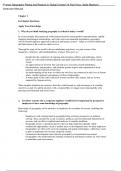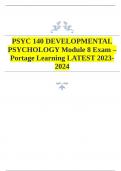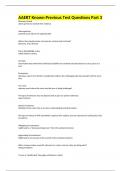(Human Geography Places and Regions in Global Context 7e Paul Knox, Sallie Marston)
(Instructor Manual)
Chapter 1
In-Chapter Questions:
Apply Your Knowledge
1. Why do you think studying geography is critical in today's world?
In an increasingly interconnected world characterized by instant global communications, rapidly
changing international relationships, and wide-scale environmental degradation, geography –
with its interdisciplinary approach to physical and human systems – helps us to better understand
the fluid nature of the world in which we live.
Through the study of the world’s diverse inhabitants and places, we gain a sense of the
uniqueness, influence, and interdependence of place. This gives us:
- Insight into the complexity of ongoing and emerging conflicts and challenges, which
allows us to develop informed opinions and make responsible decisions about current
events;
- An appreciation for diversity that can help us to overcome closed-mindedness,
discrimination, and prejudice, and facilitate greater respect and cooperation in local,
national, and international interactions;
- An understanding of the ways in which our own lives are connected to the lives of distant
others, and the material consequences of these relationships;
- A better grasp of the Earth’s physical systems and how they impact, and are in turn
impacted by, human activity.
These insights stimulate our curiosity about the world around us, and encourage us to consider
ourselves as part of a global citizenry with a responsibility to engage more meaningfully with
pressing environmental and social issues.
2. List three reasons why a corporate employer would feel it is important for prospective
employees to have some knowledge of geography.
Knowledge of geography can be attractive to employers for a number of reasons, including the
following:
- Employees with a background in geography bring a holistic perspective to problem
solving. They consider the social, economic, political, and environmental dimensions of
an issue, and can deliver sophisticated analyses of complex problems.
- Geography fosters a spatial perspective that can help employees identify viable
commercial opportunities (such as market areas or development sites) for their employers.
- Geographers are often well-versed in mapping and spatial technologies, which have come
to play an important role in many corporate sectors.
- Commercial development must often be preceded by environmental assessment.
Geographers who understand the interplay of physical and human systems are well-suited
to undertake such assessments.
,3. How does place affect identity?
Places are settings for social interaction that contribute to identity formation and maintenance in
several different ways:
- Places provide the settings for people's daily lives and their social relations; as such,
their features, amenities, and customs exert a powerful influence on our physical well-
being, opportunities, and lifestyle choices. For example, individuals who live in small
rural towns will likely have less diverse professions and lifestyles compared to those
living in large metropolitan centers featuring many amenities. In this way, places
structure our daily economic and social routines.
- Places contribute to people's collective memory and become powerful emotional and
cultural symbols. The meanings associated with highly distinctive places (such as New
York’s Times Square, or the Mall in Washington, D.C.) serve to produce a widely-shared
collective memory (i.e. of what it means to be a New Yorker, or an American), but
people also attribute a variety of different meanings to everyday, ordinary places. These
meanings can be experienced with such strength that they become a central part of an
individual’s identity, but the diversity of meanings ascribed to any one place by different
groups illustrates the extent to which places are socially constructed. For example, the
features, inhabitants, or practices that comprise a particular neighborhood may impart a
sense of belonging and community to people who grew up in that place, but outsiders
may regard the very same place with disinterest, discomfort, or even disapproval.
- Places are the sites of innovation and change, of resistance and conflict. Certain
places come to be associated with distinct cultural, political, economic, or social practices.
These practices, which can evolve over time or arise rapidly in response to challenges or
changes, can derive from (and influence) the tastes, values, and preferences of inhabitants,
and/or emerge in relation to particular characteristics or features of the location. These
place-based practices can represent new economic or cultural shifts (i.e. the late
twentieth-century rise of Silicon Valley as the center of the high-tech revolution, or the
development of hippie culture in San Francisco in the 1960s), the modification or
localization of broader changes/trends (i.e. the adaptation of rock‘n’roll into reggae in
Jamaica), or resistance to change via attempts to contest social norms (i.e. the
establishment of nuclear or GMO-free zones in some communities). Such practices often
diffuse to other locations, but remain strongly associated with their place of origin. They
may be central to how some (or even most) individuals from that place perceive
themselves (as well as how outsiders perceive them).
4. Explain how and why a particular place has mattered to you. How might others'
experience or perception of that same place differ from yours? How does your place
influence your health or job prospects?
Answers will vary, though students will likely consider the neighborhood or town in which they
grew up. In doing so, they should describe some of the features and practices associated with their
place of choice, and attempt to explain why these hold meaning for them (they may represent
certain values or ways of doing things, or evoke particular memories). They should consider how
these features/practices might be related to their own experiences, identity, lifestyle, and life
prospects. They should also consider how/why outsiders may view the same place differently
(likely because they might overlook or misunderstand some attribute of the place).
,5. What are some advantages and disadvantages of the increasing use of GIS in society?
GIS software enables analysts to link an array of variables that would otherwise be difficult to
merge, and also allows for great flexibility in the type and quantity of information that can be
integrated into an analysis. The highly detailed maps produced using GIS software yield insights
about spatial relationships that have various academic, military, and commercial applications; as a
result, GIS has become widely used by a variety of people and businesses.
The increased use of GIS has many advantages: it can render visible previously unseen aspects of
geography, allow an enormous range of problems to be addressed, contribute to more effective
military and commercial campaigns, and encourage spatial awareness and an appreciation of the
importance of maps. However, the disadvantages of this technology have also been expounded by
critics, who fear that it may be employed by those in power to increase surveillance on the
general public, or that it reduces people to sets of variables (such as where they live, or how much
money they make) that fail to capture the nuances of their needs and experiences.
6. Choose the geographic representations and tools that you would use to illustrate
alternative views of a local issue that is currently the subject of public discussion in your
community. Explain your choice.
Although answers will vary depending on the “local issue” under discussion, students should
clearly describe the issue, and explain why particular geographic representations and tools are
best suited to explore alternative views on it (they should consider at least two different views,
and cite at least two tools they would use to illustrate those views).
The tools they should consider include the following:
- Observation: What data or information will they collect? How?
o Participant observation: Perhaps they will observe local meetings or protests, or
visit the site of a proposed or existing project to get a sense of local opinions or
concerns.
o Fieldwork: Perhaps they will undertake surveys, interviews, or focus groups with
public officials, subject matter experts, and/or local residents.
o Archival searches: Perhaps they will visit an archive to establish historical
context if the issue is ongoing or has precedence elsewhere.
- Remote Sensing: Would aerial photography or satellite imagery help to show what is at
stake? If so, students should explain what features of the earth’s surface are relevant to
the alternative views being espoused. For example, aerial photography could illustrate
how a proposed highway may conveniently link two cities in their county currently
separated by a forest, but it would simultaneously illustrate the habitat destruction such a
development could entail.
- Maps: Can the information collected be usefully represented on a map? If so, students
should explain what type of map they would use and why. They should also indicate the
scale at which the map should be rendered (neighborhood, city, county, state, etc.). For
example, a thematic map of alternate views on the issue at the county level may reveal
differences of opinion along town/city lines (this would require a survey associating
opinion with place of residence), while a larger-scale map at the city level may show
further divisions between neighborhoods and communities.
, - GIS: Are there a number of factors that might be related to individuals’ take on the issue?
If so, students may consider layering variables/data sets using GIS, as such an analysis
may clearly display the concerns of particular neighborhoods or groups. For example, a
GIS analysis may show that communities opposed to a particular project are located in
close proximity to the sites being proposed for its development, or that communities who
favor the building of a given facility lack comparable amenities in their neighborhoods.
7. What is Tobler's law of geography and how does it relate to distance?
Geographer Waldo Tobler’s law of geography (devised in 1970 and often referred to as the “first
law” of geography) is that “Everything is related to everything else, but near things are more
related than distant things.” A “friction of distance” is produced by the time and cost required to
overcome distance; as such, the greater the distance between two places, the less interaction there
will be between them (the rate at which this interaction diminishes over increasing distance is
known as the “distance decay function”). Tobler’s assertion is based on two interrelated notions:
that distance is a fundamental factor in determining real-world relationships, and that distance has
a deterrent or inhibiting effect on human activity (though geographers have since established that
the deterrent effects of distance are not uniform).
8. Provide three examples of the inhibiting effect that distance has on human activity.
Students may note that the friction of distance is declining with improvements in transportation
and communication technologies, such that distance no longer has as significant an inhibiting
effect on human activity. Nevertheless, they should be able to come up with some examples of
the inhibiting effect of distance, such as the following:
- Two children that live next door to each other may play together on a daily basis, but if
one family moves, their interaction will almost certainly become less frequent, and may
cease altogether if the move is to a distant location.
- Although gasoline may be cheaper in a neighboring town, a motorist will likely elect to
purchase gas locally because doing so is more convenient.
- Refugees are most likely to seek asylum in adjacent countries because of the difficulty
involved in leaving their country of origin and traveling to a new destination. Thus,
despite the common misconception that refugees flee to wealthy countries, the UN
reports that developing countries host over 80% of the world’s refugees.
9. What is a spatial interaction?
The term “spatial interaction” broadly refers to movement and flows involving human activity.
Such movement can occur at any scale, and includes all manner of items (goods, money, culture,
ideas, humans themselves, etc.).
The fundamental principles of spatial interaction involve four basic concepts:
Complementarity: For spatial interaction to occur between two places, there must be a demand
in one place that is satisfied (or complemented) by a supply in the other. Complementarity is the
result of several factors.






